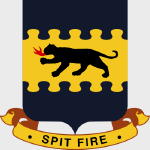Hobby Master HA8454 USAAF Republic P-47D Thunderbolt Fighter - 332nd Fighter Group "Tuskegee Airmen," Italy, 1944 (1:48 Scale)
"Why should we have a navy at all? There are no enemies for it to fight except apparently the Army Air Force."
- General Carl Spaatz, Commander of the US 8th Army Air Force, after WWII
 Nicknamed the "Jug" for its bulky shape, the Republic P-47 Thunderbolt was considered a monster of a machine. Despite its size, the Thunderbolt proved to be a fast and maneuverable warbird able to hold its own in combat. In fact, when Allied pilots climbed aboard a P-47, they knew the were in control of a fighting machine with enormous power. More importantly, they knew that if their aircraft was hit but gunfire, they had an excellent chance of making it home.
Nicknamed the "Jug" for its bulky shape, the Republic P-47 Thunderbolt was considered a monster of a machine. Despite its size, the Thunderbolt proved to be a fast and maneuverable warbird able to hold its own in combat. In fact, when Allied pilots climbed aboard a P-47, they knew the were in control of a fighting machine with enormous power. More importantly, they knew that if their aircraft was hit but gunfire, they had an excellent chance of making it home.
Refinements to the Thunderbolt continued throughout its career, leading to the P-47D, which was the most produced version with 12,558 built. The "D" model actually consisted of a series of evolving production blocks, the last of which were visibly different from the first.
The first P-47Ds were actually the same as P-47Cs. Republic could not produce Thunderbolts fast enough at its Farmingdale plant on Long Island, so a new plant was built at Evansville, Indiana. The Evansville plant first built a total of 110 P-47D-1-RAs, which were completely identical to P-47C-2s. Farmingdale aircraft were identified by the -RE suffix after the block number, while Evansville aircraft were given the -RA suffix.
The P-47D-1 through P-47D-6, the P-47D-10, and the P-47D-11 successively incorporated changes such as the addition of more engine cooling flaps around the back of the cowl to reduce the engine overheating problems that had been seen in the field. Engines and engine subsystems saw refinement, (the P-47D-10 introduced the R-2800-63, replacing the R-2800-21 seen in previous P-47s) as did the fuel, oil and hydraulic systems. Additional armor protection was also added for the pilot.
The P-47D-15 was produced in response to requests by combat units for increased range. "Wet" (equipped with fuel plumbing) underwing pylons were introduced to allow a bomb or drop tank pressurized by vented exhaust air to be carried under each wing, in addition to the belly tank.
Pictured here is a signed 1:48 scale replica of a P-47D Thunderbolt fighter that was attached to the 332nd Fighter Group "Tuskegee Airmen," then deployed to Italy during 1944.
Sold Out!
Dimensions:
Wingspan: 10-inches
Length: 8-3/4-inches
Release Date: July 2016
 Historical Account: "Red Tails" - The Tuskegee Airmen is the popular name of a group of African American pilots who fought in World War II. Formally, they were the 332nd Fighter Group of the U.S. Army Air Corps.
Historical Account: "Red Tails" - The Tuskegee Airmen is the popular name of a group of African American pilots who fought in World War II. Formally, they were the 332nd Fighter Group of the U.S. Army Air Corps.
The Tuskegee Airmen were the first African American military aviators in the United States armed forces. During World War II, African Americans in many U.S. states still were subject to Jim Crow laws. The American military was racially segregated, as was much of the federal government. The Tuskegee Airmen were subject to racial discrimination, both within and outside the army. Despite these adversities, they flew with distinction. They were particularly successful in their missions as bomber escorts in Europe.
By the end of the war, the Tuskegee Airmen were credited with 112 Luftwaffe aircraft shot down, the German-operated Italian destroyer TA-23 sunk by machine-gun fire, and destruction of numerous fuel dumps, trucks, and trains. The squadrons of the 332nd FG flew more than 15,000 sorties on 1,500 missions. The unit received recognition through official channels and was awarded a Distinguished Unit Citation (DUC) for a mission flown March 24th, 1945, escorting B-17s to bomb the Daimler-Benz tank factory at Berlin, Germany. During the action its pilots were credited with destroying three Me-262 jets of the Luftwaffe's all-jet Jagdgeschwader 7 in aerial combat that day, despite the American unit initially claiming 11 Me 262s on that particular mission. Upon examination of German records, JG 7 records, just four Me 262s were lost and all of the pilots survived. In return the 463rd Bomb Group, one of the many B-17 groups the 332nd were escorting, lost two bombers, and the 332nd lost three P-51s during the mission. The bombers also made substantial claims, making it impossible to tell which units were responsible for those individual four kills. The 99th Fighter Squadron in addition received two DUCs, the second after its assignment to the 332nd FG. The Tuskegee Airmen were awarded several Silver Stars, 150 Distinguished Flying Crosses, 8 Purple Hearts, 14 Bronze Stars, and 744 Air Medals.
In all, 994 pilots were trained in Tuskegee from 1941 to 1946, approximately 445 were deployed overseas, and 150 Airmen lost their lives in accidents or combat.


